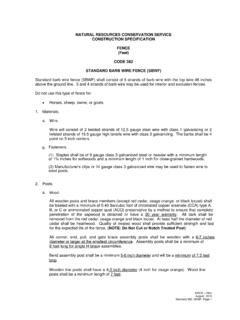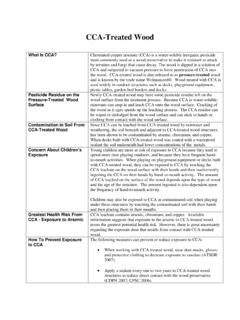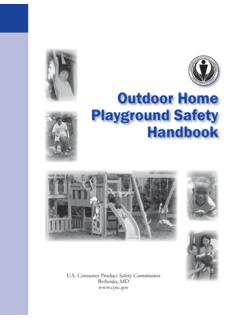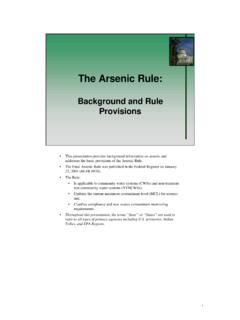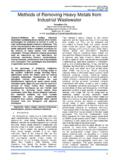Transcription of Timber Pile Design and Construction Manual
1 PREFACEThis Timber pile Design and Construction Manualhas been developed by the Southern Pressure Treaters' Associat ion as its officialrecommendation for Timber PilingDesignand Construction . The data in this publication has been prepared in accordance with recognized engineering principlesand is based on available tec hnical data. The information in this Manual should not be used or relied upon for a specific application without competent professional examination and verification of its accuracy, suitability, and applicability by a licensed professional engineer. Bypublication of this Manual ,SPTAint ends norepresentation or warranty, expressed or implied, that the information in themanual is suit able forany specific application or is free frominf ringement ofany patent or copyright.
2 Any user of this informationassumesall risk and lia bility arising from such use. The Manual was developed to assist Design engineers with the Design of Timber piling. ManualAuthor: James G. Collin, , , The Collin Group, was reviewed by theSPTA Timber pile Manual Technical and Revised 2016 by Edward D. Entsminger, , Rubin Shmulsky, , andJeanie McNeel, Department of Sustainable Bioproducts, Mississippi State Timber PileManual Technical CommitteeKevin RagonTom O Malley Grady BraffordRandy KellyMorgan WrightSpecial thanks is given to thefollowingfor theiradvice on R. Berg, ,Ryan R. Berg & AssociatesMartin Rollins, , H. M. Rollins Company, Inc. Future changes to this manualwill beposted on the following website.
3 Southern Pressure Treaters' Association 2002 All rights reserved. Printed in the of Sustainable BioproductsWestern Wood Preservers InstitutePile Driving Contractors AssociationDeep Foundations Institute Tim ber pile Des ign and Construction Manual Table of Contents Introduction Scope of Manual Background Seismic Design Considerations Organization of Manual Founda tion Design Procedure Design of Foundations Founda tion Design Process Timber pile Properties Introduction Allow able Stress Design Tabula tion of Allowable Stress and pile Capacity 1 pile Ca pacity pile Size Specifications Working Strength B ased on Small Clear W ood Specimens 1 Axial Compressive Stress Extreme Fiber Bending Stress 3
4 Co mpressive Stress Perpendicular to the Grain 4 S hear Stress Perpendicular to the Grain 5 Modulus of Elasticity Allow able Stress 1 L oad Duration 2 Temperature 3 Pressure T reat ment Size 5 L oad Sharing 6 Allow able Stress Preservative Process 1 Cr eoso te 2 Chromated Copper Arsenate (CCA) .1 CCA Industrial Uses 3 Ammoniacal Copper Zinc Arsenate (ACZA) 4 CC A and ACZA 5 Preservative Retenti on Pentachlorophenol and Copper Naphthenate Durability Considerations Environmental Considerations Static Analysis Design Procedures Introduction Soil/ pile Interaction 1 L oad T ransfer Factors of Safety Engineering News Formula Wave Equation Analysis Dynamic Monitoring Design of Single Piles Introduction Meyerhof Method for Piles in Cohesionless Soils Nordlund Method for Piles in Cohesionless Soils Alpha ( )
5 Met hod for Piles in Cohesive Soils Effective Stress Method for Piles in Cohesionless and Cohesive Soils Nottingham and Schmertmann Method Uplift Capacity of Single Piles Design of pile Groups Introduction Axial Capacity o f Pi le Gro ups in Cohesionless Soils Axial Capacity of pile Groups in Cohesive Soils Settlement of pile Groups in Cohesionless Soils Settlement of pile Groups in Cohesive Soils Lateral Design Considerations Introduction Broms Method pile Installa tion Introduction pile Driving Equipment 1 L eads 2 pile Hammers 3 Helmet Hammer Size Selection pile Accessories pile Cutoffs pile Load Testing Introduction Axial Compression Static Load Test 1 Interpretation of Load Test Q uali ty Assurance During pile Driving Introduction Tim ber pile Quali ty Requirements Material Certification pile Driving Equipment and pile Installation S pecifications Introduction Material Specification G eotechnical Considerations Introduction Planning Site Investi gation.
6 1 Desk Study Avail able Existing Data .2 Field Reconnaissance Gu ideli nes for Minimum Subsurface Exploration Program Methods of S ubsurface Exploration .1 Hollow-Stem Auge rs .2 Rota ry Wa sh Borings .3 Test (Exploration) Pit Excavation So il and Rock Sampling .1 So il Sa mplers Groundwater Conditions S ubsurface Profile Development In-Situ Soil Testing .1 Cone Penetration Test (CPT) .2 V ane Shear Test Laboratory Soil Testing .1 I ndex Tests .2 S hear Strength Tes ts .3 Consolidation Tests Laboratory Testing for pile Driveability Determination References Appe ndix A Design Example Problems Problem 1 Meyerhof Method Nordlund Method Problem 2 Alpha ( ) Met hod Problem 3 Effective Stress Method CHAPTER INTRODUCTION SCOPE OF Manual All objects and structures transfer their load either directly or indirectly to the earth.
7 The capacity of the earth to support such loads depends on the strength and stability of th e supporting soil or rock materials. Not all foundation materials possess the required characteristics to carry imposed loads or to resist natural or man-made forces without resulting in damage to the structures they support. Consequently, the engineer is faced with the task of designing foundations to distribute high-intensity loads in a manner that can be supported by existing natural subgrade materials, and/or modifying those natural materials. There are three basic approaches to achieving proper support of structures. These are: a) distribution of structural loads to foundations, such that the intensity of t he loads transferred will not cause shear failure or objectionable settlement of the structure; b) modification of the foundation soil ( , soil improvement ); or c) a combination of "a" and "b" above.
8 There are two general types of foundations for distributing applied structural loads to the ground: shallow foundations, and deep foundations. Shallow foundations principally distribute structural loads over large areas of near-surface soil to lower the intensity of the applied loads to levels tolerable for the foundation soils. The analysis and Design of shallow foundations is not discussed in this Manual . Deep foundations distribute loads to deeper, more competent soils or to rock, by means of skin-friction, end bearing, or a combination of both. This Manual is devoted to the discussion of the structural and geotechnical aspects of Timber pile foundation Design . This Design Manual follows the Design methodology presented in the Federal Highway Administration s Design and Construction of Driven pile Foundations (FHWA-NHI-05-042 and 043).
9 The information from this FHWA document has been condensed to focus solely on timberpiles and has been supplemented to provide additional guidance with respect to the selection of Timber pile structural properties required for Design . BACKGROUND Timber piles have successfully supported structures for more than 6,000 years. Over the years, the methods that man has employed to extend the life of Timber piling have evolved to the point that Timber piles will last for over 100 years. Ancient civilizations used various animal, vegetable, and mineral oils to preserve Timber . In Roman times, timbers were smeared with cedar oils and pitch, then charred to extend their service life. Roman roads built on treated piles were still in good condition 1,900 years later.
10 A building built in Venice, Italy in 900 was rebuilt around 1900 on the same 1,000-year-old piles. The modern age of wood preserving began in England in 1832. Pressure injection of coal-tar creosote into wood beg an in 1838. Following the successful use of pressure treated railroad ties, railroads started treating foundation piles in the early 1880 s. Timber pile Design and Construction ManualPage 1 Since then, pressure treatment has been recognized as a process that protects wood by extending its life indefinitely. This is why building codes require wood for ce rtain uses to be treated and why cod es explicitly define treated as pressure treated. In recent years, extensive load tests have been performed on pressure treated ti mber foundation piles.

